Identification of the acetaldehyde oxide Criegee intermediate reaction network in the ozone-assisted low-temperature oxidation of trans-2-butene†
Abstract
Uni- and bi-molecular reactions involving Criegee intermediates (CIs) have been the focus of many studies due to the role these molecules play in atmospheric chemistry. The reactivity of CIs is known to strongly depend on their structure. The reaction network of the second simplest CI, acetaldehyde oxide (CH3CHOO), is investigated in this work in an atmospheric pressure jet-stirred reactor (JSR) during the ozonolysis of trans-2-butene to explore the kinetic pathways relevant to atmospheric chemistry and low-temperature combustion. The mole fraction profiles of reactants, intermediates, and final products are determined by means of molecular-beam mass spectrometry in conjunction with single-photon ionization employing tunable synchrotron-generated vacuum ultraviolet radiation. A network of CI reactions is identified in the temperature region below 600 K, characterized by CI addition to trans-2-butene, water, formaldehyde, formic acid, and methanol. No sequential additions of the CH3CHOO CI are observed, in contrast with the reactivity of the simplest CI (H2COO) and the earlier observation of an extensive reaction network with up to four H2COO sequential additions (Phys. Chem. Chem. Phys., 2019, 21, 7341–7357). Experimental photoionization efficiency scans recorded at 300 K and 425 K and ab initio threshold energy calculations lead to the identification and quantification of previously elusive intermediates, such as ketohydroperoxide and hydroperoxide species. Specifically, the C4H8 + O3 adduct is identified as a ketohydroperoxide (KHP, 3-hydroperoxybutan-2-one, CH3C(![[double bond, length as m-dash]](https://www.rsc.org/images/entities/char_e001.gif) O)CH(CH3)OOH), while hydroxyacetaldehyde (glycolaldehyde, HCOCH2OH) formation is attributed to unimolecular isomerization of the CIs. Other hydroperoxide species such as methyl hydroperoxide (CH3OOH), ethyl hydroperoxide (C2H5OOH), butyl hydroperoxide (OOH), hydroperoxyl acetaldehyde (HOOCH2CHO), hydroxyethyl hydroperoxide (CH3CH(OH)OOH), but-1-enyl-3-hydroperoxide, and 4-hydroxy-3-methylpentan-2-one (HOCH(CH3)CH(CH3)C(
O)CH(CH3)OOH), while hydroxyacetaldehyde (glycolaldehyde, HCOCH2OH) formation is attributed to unimolecular isomerization of the CIs. Other hydroperoxide species such as methyl hydroperoxide (CH3OOH), ethyl hydroperoxide (C2H5OOH), butyl hydroperoxide (OOH), hydroperoxyl acetaldehyde (HOOCH2CHO), hydroxyethyl hydroperoxide (CH3CH(OH)OOH), but-1-enyl-3-hydroperoxide, and 4-hydroxy-3-methylpentan-2-one (HOCH(CH3)CH(CH3)C(![[double bond, length as m-dash]](https://www.rsc.org/images/entities/char_e001.gif) O)CH3) are also identified. Detection of additional oxygenated species such as methanol, ethanol, ketene, and aldehydes suggests multiple active oxidation routes. These results provide additional evidence that CIs are key intermediates of the ozone-unsaturated hydrocarbon reactions providing critical inputs for improved kinetics models.
O)CH3) are also identified. Detection of additional oxygenated species such as methanol, ethanol, ketene, and aldehydes suggests multiple active oxidation routes. These results provide additional evidence that CIs are key intermediates of the ozone-unsaturated hydrocarbon reactions providing critical inputs for improved kinetics models.

- This article is part of the themed collection: 2021 PCCP HOT Articles


 Please wait while we load your content...
Please wait while we load your content...
